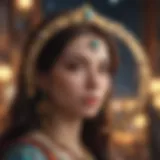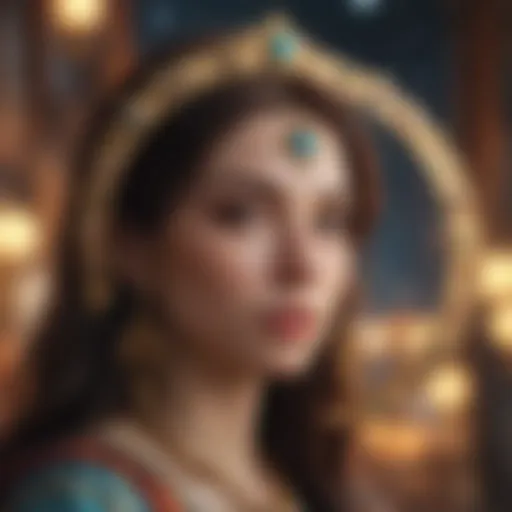Exploring Daily Tarot Readings for Personal Growth
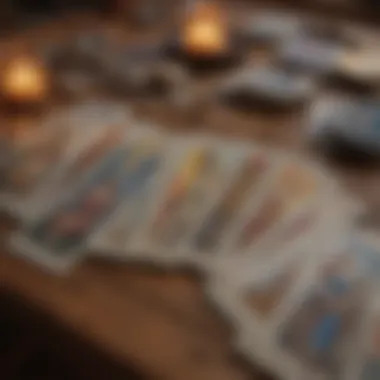

Intro
In a world often filled with noise and distraction, tarot readings whisper subtle truths waiting to be unveiled. Each day offers an opportunity—a chance to reflect through the prism of tarot cards. These cards provide a mirror to our thoughts and feelings, shedding light on our inner landscape. While tarot is often associated with fortune telling, it can be a far deeper practice, serving as a tool for personal insight and growth.
The allure of daily tarot readings lies in their ability to connect us to our intuition and spark self-reflection. Whether you are a seasoned practitioner or just dipping your toe into this mystical art, the transformative power of tarot can illuminate the path ahead.
Through exploring various tarot spreads and understanding the significance of individual cards, readers can uncover layers of meaning that resonate with their life experiences. This article aims to guide you through the world of tarot, revealing its history, explaining its techniques, and demonstrating how it can serve as a reliable compass in the journey of life.
Let's take a closer look at how the landscape of the tarot unfolds, enriching our personal narratives and decision-making processes.
Foreword to Daily Tarot Reading
In the fast-paced life we lead today, finding a moment to pause and reflect can feel like searching for a needle in a haystack. Daily tarot reading offers not only a chance to reconnect with oneself but also serves as a lens through which to gain deeper insights into personal experiences. Engaging with tarot cards on a daily basis can bolster self-awareness and emotional intelligence. This ritual, rooted in ancient practice, allows individuals to unravel their thoughts and feelings, shedding light on the complex web of life.
Understanding the nuances of daily tarot reading is paramount for those seeking clarity. It’s not just about fortune-telling; it’s an intimate dialogue between the self and the universe. By drawing cards every day, practitioners can cultivate a habit of introspection. Over time, this practice fosters a routine that encourages personal growth and accountability.
Understanding Tarot Cards
Tarot cards are more than mere pieces of illustrated cardstock; they're powerful symbols that encapsulate broader themes and messages. Each card carries its own significance, shaped by mythology, psychology, and human experience. For instance, the fool card often symbolizes new beginnings and innocence, while the tower depicts unexpected upheaval. When drawn, these cards can resonate with one’s current situation, prompting reflection on what these themes might be personally speaking to.
A fundamental aspect of tarot reading is deciphering the meanings behind each card. Major Arcana cards convey pivotal life events or spiritual lessons, whereas Minor Arcana cards offer insights into daily challenges and experiences. Engaging with these images can stir the imagination, prompting individuals to think critically about their choices and circumstances.
Incorporating daily tarot readings into one’s life requires a dedicated and open mindset. It’s essential to clear one’s thoughts and create a comfortable environment. Whether it’s a cozy corner in one's home or a peaceful park, the space should invoke feelings of safety and serenity. Moreover, if one has a favorite tarot deck, familiarity with the imagery can enhance the reading, making each session feel more personal.
Historical Context of Tarot
To appreciate the significance of daily tarot readings, one cannot overlook the rich history of tarot itself. Originating in the 15th century, tarot cards were initially used for games rather than divination. In the 18th century, however, their popularity shifted dramatically towards esotericism. The mystique surrounding tarot began to flourish with figures like Antoine Court de Gébelin, who proposed that tarot was an ancient Egyptian method of divination.
As tarot evolved, various interpretations and decks emerged, each contributing to its mystique. From the classic rider-waite to more contemporary designs, tarot decks offer diverse perspectives, catering to the varied psychologies of their users. This historical lens not only provides context but also reiterates the adaptability of tarot, reflecting the culture and sentiments of the time.
Further understanding the history of tarot can elucidate the underlying principles guiding daily readings. With roots that intertwine art, psychology, and nature, tarot serves as a bridge linking users to the realm of intuition and insight. This historical depth offers richness to the practice, allowing individuals today to draw on centuries of wisdom while navigating their own life's journeys.
The Mechanics of Daily Tarot Readings
Understanding the mechanics behind daily tarot readings provides a strong foundation for their effective utilization. It’s not just about the cards themselves but also involves the connection between the reader, the environment, and the psychological approach taken during the reading. This section delves into choosing the right tarot deck and establishing impactful reading rituals, both crucial components that enhance personal insight and clarity.
Selecting a Tarot Deck
Types of Tarot Decks
Different types of tarot decks exist, each with their own essence and narrative that can resonate with a reader. Traditional decks like the Rider-Waite-Smith are famous not just because of their extensive use but also for their vivid imagery and detailed symbolism. The strong illustrations can help clarify meanings, making it easier for beginners.
Conversely, there are contemporary decks like the Wild Unknown, which can present a more intuitive approach focusing on personal interpretation. These unique features enhance the experience for those who might find traditional decks too restrictive or challenging.
The choice of a tarot deck is not merely a matter of aesthetics; it can significantly shape the reading experience. The imagery and symbolism should evoke a personal response, almost as if the cards are conversing with the reader.
While one deck may feel vibrant and alive, another might seem cold and rigid. This subjectivity is crucial because when a reader is comfortable with their deck, the connection allows for deeper insights during the reading.
Choosing Based on Personal Connection
When it comes to tarot, making a personal connection to the deck is indispensable. This emotional bond can deepen the intuitive process, allowing the user to engage more meaningfully with the cards. For example, a deck featuring artwork or themes that align with one's personal beliefs or cultural background can resonate on a different frequency.
A personal connection often leads to trust in the readings provided by the cards. When readers feel an authentic bond, they are more likely to interpret the cards correctly and intuitively. This could be the difference between a generic and a powerful reading.
Having a deck that feels like an extension of oneself can have numerous advantages. It can ignite curiosity and enhance exploration, leading to transformative experiences that transform a casual reading into a comprehensive introspection session. On the flip side, poorly chosen decks may hinder clarity and create confusion, making the efforts feel futile.
Daily Reading Rituals
Creating a Sacred Space


The environment in which a reading occurs can greatly influence the outcome. Creating a sacred space allows for better concentration and enhances the clarity of insights. This environment doesn’t need to be elaborate—a simple corner of your home can be transformed into a serene spot with just a few essential items like candles, crystals, or even fresh flowers.
The key characteristic of this sacred space is its ability to absorb and amplify the intentions of the reader. It acts almost as a canvas upon which the energies of the reading can be painted. Ensuring that distractions are minimal allows for a deeper connection to the cards and the questions being posed, facilitating a flow of intuitive insights that might otherwise be muted by external noise.
While preparing this space, practitioners often add personal touches that hold special significance, anchoring them to their spiritual journey. This forms a powerful ritual that not only enhances focus but also anticipates and prepares the mind for the issues at hand.
Setting Intentions for the Reading
Setting intentions is another critical aspect that can dramatically change the nature of a reading. Before flipping the first card, grounding oneself and formulating specific intentions can clear mental clutter. Whether it's seeking guidance for a particular question or exploring an area of personal doubt, having a clear intention invites purpose into the process.
The distinct characteristic of this practice is its ability to cultivate mindfulness. By focusing the mind on a particular aim, readers can sharpen their intuitive faculties, allowing the cards to guide them more accurately towards the answers they seek. This intention-setting ritual not only promotes clarity but also instills a sense of accountability in the inquiry—one cannot simply meander through the reading.
The process could involve a simple mantra or visualization, imbuing the reading with a heightened sense of meaning. However, it's essential that the intentions remain flexible; sometimes the cards might direct one towards pathways not initially considered. But this adaptability is where the true beauty of tarot lies: uncovering insights one didn’t even realize were needed.
Interpreting the Cards
Interpreting the cards is at the heart of daily tarot readings. It allows individuals to derive personal insight and engage in meaningful self-reflection. When one draws a card, it is not merely a random selection; it opens doors to understanding the current state of mind, emotions, and situational influences. Each card symbolizes different aspects of life, and interpreting these meanings collectively can lead to profound revelations about one’s circumstances and choices.
Understanding Card Meanings
Major Arcana vs Minor Arcana
The distinction between Major and Minor Arcana cards holds significant weight in the tarot world. The Major Arcana, consisting of twenty-two cards, represents fundamental life lessons and spiritual milestones. They often point towards crucial life themes, such as The Fool's journey of beginning anew or Death, which symbolizes transformation. These cards draw attention to pivotal moments or phases in one’s life, showcasing insights that carry a deeper resonance.
On the flip side, the Minor Arcana focuses on everyday experiences and challenges. Comprising fifty-six cards, it is divided into four suits: Cups, Pentacles, Swords, and Wands, reflecting various areas of human endeavor. Whether it’s the emotional weight of the Cups or the intellectual pursuits represented by Swords, these cards provide context and texture to daily life challenges.
The significance of understanding these divisions lies in how each arcana layers the reading at hand. Major Arcana cards may indicate profound shifts, while Minor Arcana details the smaller, yet equally critical, influences. This layered approach allows readers to navigate complex narratives with agility.
Common Interpretations
Diving into Common Interpretations expands one’s tarot vocabulary, enabling readers to articulate the messages the cards convey. Each card carries a multitude of meanings that can shift based on context. For instance, the Tower card is often seen as a symbol of chaos and upheaval, but it can also suggest necessary change and revelation. Likewise, the Sun card radiates positivity but may also indicate superficiality in certain contexts.
Understanding these interpretations aids in constructing a clear picture when engaging in daily readings. Familiarity with common interpretations enhances the reader’s intuition, allowing it to flow more freely. Individual interpretations should remain flexible, prompting readers to trust their instincts while weighing traditional meanings.
Combining Cards in a Spread
Combining cards within a spread provides an enriching layer to daily readings. This synergy not merely connects individual card meanings, but it breathes new life into them. When seeing how two or more cards interact, one can unveil intricate relationships between various life aspects, leading to unforeseen insights.
Interpreting Relationships Between Cards
Interpreting Relationships Between Cards is a crucial skill for any tarot practitioner. By looking beyond the surface of single cards and observing how they interact in a spread, one can discern underlying themes and connections. For instance, if one draws the Empress alongside the Three of Swords, it could stimulate thoughts about nurturing oneself despite experiencing heartache. Recognizing such interrelations empowers the reader to make nuanced interpretations, enabling guidance that feels more symbiotic than simplistic.
Recognizing Patterns
Furthermore, the practice of Recognizing Patterns within readings fosters a deeper understanding of personal narratives. As readers engage consistently with their daily tarot, they may start noticing recurring symbols, numbers, or card combinations. This repeated interaction not only reinforces understanding but also fosters a sense of trust in the process. Patterns, whether they rise from the same suit or repeat certain cards, reflect areas where attention is needed in one's life, thus serving as pivotal indicators for growth or change.
The confluence of these elements illustrates how Interpreting the Cards serves as a vehicle for personal insight. Each reading becomes a lens through which life experiences can be examined and better understood, fostering a richer self-awareness.
Common Tarot Spreads for Daily Readings
Daily tarot readings can greatly benefit from specific spreads that are tailored to reveal insights tailored to the individual's needs. Common tarot spreads are like blueprints; each offers a unique way to interpret the cards, helping to clarify personal insights and guide actions. In the realm of tarot, these spreads improve the effectiveness of readings.
Using the right spread can magnify the power of the cards drawn, revealing layers of meaning that might otherwise go unnoticed. Each commonly used layout has its strengths and weaknesses, and understanding these nuances can enrich the reader's experience. The spreads discussed below encompass a range of uses, from straightforward interpretations to complex inquiries into one's emotional and psychological landscape.
Single Card Draw
The single card draw is the simplest spread, yet it holds profound significance. This method involves drawing just one card each day. It's beneficial because it allows for focused contemplation on a specific question or theme for the day.
The beauty of this approach lies in its straightforwardness; it can be done quickly, making it easy to integrate into a busy routine. A single card can serve as a touchstone for reflection, giving clear guidance without overwhelming the reader with information.
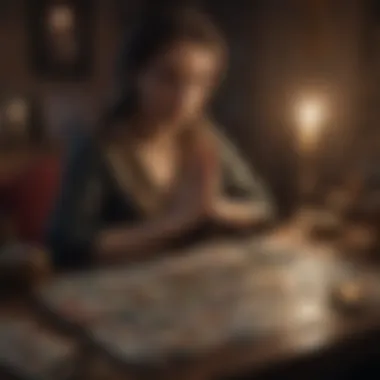

Three-Card Spread
The three-card spread is a staple of tarot practice, popular for its ability to provide more depth and context than a single draw. It typically involves drawing three cards that can represent different aspects of a situation or time frame, such as past, present, and future.
Past, Present, Future Interpretation
This interpretation serves as a timeline that connects one's history, current circumstances, and potential future. Each card's placement informs the reading, creating a narrative that holds value for self-discovery. One key characteristic of this setup is its simplicity; it actively urges the reader to contemplate how their past experiences shape their current situation and future decisions. Its popularity stems from its clarity and ability to frame complex situations. However, a limitation might be the inclination to dwell excessively on the past, which could overshadow present happenings.
Situational Analysis
Situational analysis can give rich context to current dilemmas. Here, the first card represents the past influences, the second card shows what's happening now, and the third card points to possible future outcomes. This method allows the reader to dissect a specific scenario deeply, giving clear direction amid uncertainty. A prominent feature of this analysis is its adaptability. Readers can tailor it to various questions or situations, which makes it a flexible and popular choice. However, the downside is that a reader might feel overwhelmed by the heavy focus on multiple facets, leading to confusion in interpretation.
Celtic Cross Spread
The Celtic cross spread offers a comprehensive insight into a person's life or situation. This layout features ten cards, addressing various aspects like challenges, unconscious influences, and future possibilities.
Comprehensive Insight
One of the strengths of using the Celtic cross for daily readings is its ability to provide a multi-dimensional view of one's life. It allows you to explore deeper psychological layers alongside external world influences. This level of depth makes it a beneficial choice for someone looking to unpack intricate problems. However, its complexity can be off-putting to beginners.
Utilizing for Daily Reflection
When used as a daily reflection tool, the Celtic cross can guide personal growth by illuminating the mind's unconscious trails. The specific aspect of relating many cards to various areas of life encourages a holistic view of challenges and triumphs alike. Its key characteristic is how it calls for patience and time for reflection. Readers may find this method rewarding, as it unravels various threads of their existence. Yet, some might find the sheer amount of information daunting.
"Daily tarot readings, through these diverse spreads, serve not just as guidance but as a means of crafting a compelling narrative for self-exploration."
Practical Applications of Daily Tarot Readings
Daily tarot readings hold a mirror up to our lives, allowing us to peer deeper into our thoughts, emotions, and decisions. This ancient practice is not just a mystical ritual; It plays a crucial role in facilitating self-reflection and guiding us in our daily lives. By engaging with tarot regularly, we cultivate a more profound understanding of ourselves, paving the way for growth and clarity.
Facilitating Self-Reflection
Promoting Personal Accountability
One of the prime advantages of tarot is its power to promote personal accountability. When one draws a card, it often serves as a prompt to evaluate one's actions and behaviors that may need reassessment. This unique feature of tarot encourages individuals not only to confront their current feelings and situations but also to acknowledge what they've done to either benefit or hinder their growth.
A key characteristic of personal accountability in this context is its capacity to foster honesty. The tarot's imagery and symbolism often resonate with our own experiences, leading us to make connections we might otherwise overlook. Through this, readers are nudged to take responsibility for their choices, strengths, and weaknesses, making it a beneficial aspect of daily readings.
However, some might find it challenging to embrace this aspect of tarot. Grappling with one’s own shortcomings can be daunting. Yet, the long-term benefits outweigh such discomfort. By facing these truths, one can cultivate resilience and develop a stronger sense of self.
Clarifying Thoughts and Emotions
The act of drawing tarot cards can also aid in clarifying thoughts and emotions. Such clarity is invaluable in the chaotic whirl of modern life where feelings can often become muddled. Each card can act as a catalyst, allowing a person to verbalize feelings they might have kept bottled up or unexamined.
This characteristic of clarity isn't just beneficial; it becomes a lifeline for many. In the nuances of daily readings, individuals discover insights that challenge their assumptions. A single card can spark revelations about one's emotional state or mental barriers, guiding the reader toward a more balanced mindset.
Nevertheless, interpreting these emotions through tarot can sometimes lead to misunderstandings if one relies solely on surface meanings. Therefore, it's essential to delve deeply and engage earnestly with the messages each card presents. Encouraging ongoing dialogue with oneself is pivotal here, as deeper reflections about these insights can lead to profound personal development.
Navigating Life Decisions
Beyond self-reflection, navigating life decisions is another vital application of daily readings. Tarot functions not only as a reflective tool but also as a compass for decision-making. Readers often find themselves at a crossroads, and a tarot spread can help illuminate paths they had not considered.
Using Tarot for Guidance
Employing tarot as a means of guidance in times of uncertainty can be an enlightening experience. By asking targeted questions during a reading, individuals are offered clarity on various options and their potential outcomes. The beauty of tarot lies in its ability to provide personalized insights, rooted in the unique context of one’s life.
The guidance aspect can be particularly empowering. Readers often feel validated as cards confirm suspicions or shed light on paths to pursue—or avoid. However, it’s crucial to remember that guidance through tarot should coexist with one’s own intuition and reasoning; it isn’t a decision-maker but rather a supportive ally.
Empowering Choices
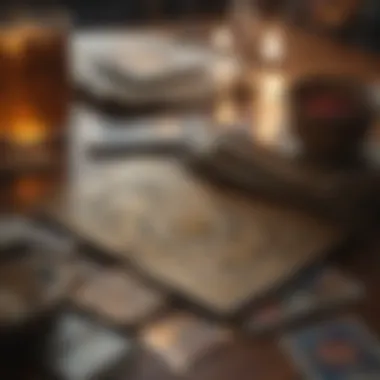

Lastly, using tarot can be an effective means of empowering choices in life’s myriad of challenges. Each card pulled can offer incremental boosts of confidence, enabling readers to feel more equipped to tackle hurdles—whether they be personal, professional, or relational. The sense of empowerment comes from understanding that they possess the agency to create change in their lives and choices.
However, it's good to balance this feeling of empowerment with a grounded approach. Relying solely on tarot without attributing one’s will to navigate situations may lead to a passive mindset. Being active participants in our narratives, while still drawing wisdom from the tarot, allows for holistic empowerment.
In summary, the practical applications of daily tarot readings extend beyond mere curiosity or entertainment. They hold the potential for deep self-discovery, clarity, and guidance, enriching one’s personal insight. Engaging with this practice opens doors to self-awareness and informed choices, providing essential tools for navigating life’s complexities.
Common Misconceptions about Tarot
When it comes to tarot cards, many folks are understandably skeptical or carry a certain misconception. These misunderstandings can stem from a variety of sources, including popular media and cultural stereotypes. Addressing these common misconceptions is important, as it allows for a clearer understanding of what daily tarot reading can truly offer.
Daily tarot readings are often viewed through a narrow lens, primarily linked to fortune telling. However, the reality is much richer and layered. Engaging with tarot cards daily serves more as a tool for self-exploration and personal insight rather than a crystal ball for future predictions. Here’s a closer look at some frequent misunderstandings regarding tarot.
Tarot as Fortune Telling
A prevalent myth is that tarot cards are purely for predicting the future. While it's true that many individuals consult tarot with the hope of gaining foresight, this view simplifies a much more complex practice. Daily readings aren't about definitive outcomes; instead, they provide perspectives, archetypes, and deep insights into one’s current state of being. The cards reflect the querent's emotional landscape and potential paths forward rather than set stones of predetermined fate.
Consider the experience of someone pulling a card for the day: it might be The Fool, symbolizing new beginnings and a leap into the unknown. Instead of saying, "You'll embark on a grand journey," it instead nudges the person to contemplate what new ventures might be on the horizon for them. Acknowledging this dimension transforms tarot from mere fortune telling to a powerful tool for introspection.
Skepticism and Belief
Engaging with tarot cards often invites both skepticism and belief, creating a unique dichotomy that can enrich one’s personal practice. There are varied beliefs surrounding tarot, and understanding this balance can lead to greater insights. Skepticism keeps a grounded approach, while belief opens the heart and mind.
The Balance of Rationality and Intuition
Finding a sweet spot between rationality and intuition is key when approaching tarot. Rationality ensures that practitioners remain critical thinkers while engaging with the cards, avoiding dogmatic beliefs that can detract from genuine exploration. On the other hand, intuition allows for a deeper connection with the readings, interpreting symbols and messages in a more holistic manner.
This balance is beneficial as it broadens the horizon for practitioners. Being overly skeptical could lead one to miss insightful moments the cards can provide, while being too intuitive without any grounding might lead to flights of fancy.
The unique feature of this balance lies in its flexibility. For instance, someone might draw the Death card. From a rational point of view, they can consider external life changes, while their intuitive self can explore what the end of a phase might signify emotionally and psychologically. This duality enriches the experience of tarot.
Respecting Diverse Perspectives
Tarot positions itself within a tapestry of beliefs—some see it as divination, while others embrace it for psychological insight. Respecting these diverse perspectives leads to a more nuanced comprehension of its practice. In this context, there’s no one-size-fits-all approach to tarot; each person has their unique way of relating to it.
Understanding and honoring different beliefs surrounding tarot can deepen one’s own practice. It fosters an environment where practitioners feel safe to explore their beliefs and apprehensions without judgment. This inclusivity is beneficial as it opens dialogues and discussions, enriching the community’s understanding of the craft.
The distinct advantage of respecting these varied views lies in broadening one’s personal practice. For example, someone who firmly believes in tarot's predictive power might learn from a practitioner who emphasizes the psychological benefits of tarot readings. Their interactions ignite a transformative learning process that fuels richer tarot experiences.
“Every tarot card possesses a deep, multifaceted meaning, inviting us to explore not just predictions but the very essence of our lives.”
In summary, dissecting these misconceptions sheds light on the valuable role daily tarot readings can play in personal insight. By embracing an informed approach, one can navigate through skepticism to truly appreciate the beauty of tarot as a reflective practice. Those who engage with tarot, balancing belief and skepticism, will find deeper understanding and greater self-awareness.
Closure: The Evolving Relevance of Daily Tarot Readings
Daily tarot readings serve as a bridge to personal insight, offering practitioners a unique lens through which to view their thoughts and behaviors. This conclusion emphasizes that the relevance of tarot has only grown as society grapples with complexities of modern life. It's a tool that resonates with the age-old pursuit of self-understanding, but it's been adapted to fit contemporary needs.
In an era marked by rapid changes and uncertainty, engaging with tarot can feel like finding an anchor. Many find comfort in the ritual of drawing cards each day, where the simple act of focusing on a few chosen symbols can illuminate one's inner workings. In this context, tarot becomes more than a mystical pastime; it evolves into a vital practice of daily introspection.
Integrating Tarot into Daily Life
Integrating tarot into daily routines isn't just about pulling cards; it's about setting an intention that guides your journey. When one considers how to merge this ancient practice with modern life, it requires a bit of creativity. Here are ways to make tarot a part of your everyday experience:
- Morning Rituals: Start your day by drawing a card, reflecting on its meaning and how it may align with your expectations for the day.
- Journaling: Combine your readings with journaling, documenting insights and feelings that arise. This helps track your growth over time.
- Guided Discussions: Engage with a community of fellow tarot enthusiasts. Sharing interpretations enriches the understanding and keeps the practice lively.
- Creative Expression: Use tarot cards as a prompt for art, poetry, or other forms of creative expression. This breathing life into the symbols can deepen their meanings.
The key here is consistency. Like watering a plant, regular engagement with tarot nurtures your ability to interpret and understand these powerful symbols.
Encouraging Continuous Exploration
The exploration of tarot is a lifelong journey. The cards have layers of meaning that reveal themselves over time, as well as through various experiences and challenges. This continuous exploration fosters a dynamic relationship between the individual and the tarot.
- Study Different Decks: Each tarot deck tells a different story. Trying various decks can introduce new perspectives and interpretations.
- Mythology and Symbolism: Dive deep into the stories and symbols of the cards. Understanding cultural influences and historical contexts can make readings richer.
- Workshops and Courses: Attend classes or workshops designed to enhance your skills and knowledge. Engaging with seasoned practitioners can enlighten your practice.
- Reflections on Personal Growth: Periodically revisit past readings to examine how your interpretations have shifted and evolved. This is a testament to your personal growth and the fluidity of tarot's insight.
Daily tarot readings, therefore, are not static. They demand an evolving engagement that reflects ongoing learning and personal development.
"Tarot is a mirror, illuminating the pathways we might not yet see, guiding us as we navigate our individual journeys."
The importance of continually engaging with tarot not only invites personal insight but also opens the door for deeper, broader exploration of the self in the context of the universe around us.




